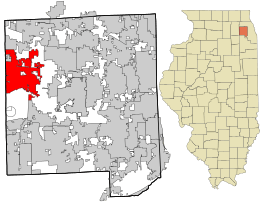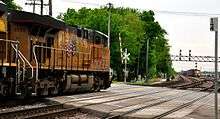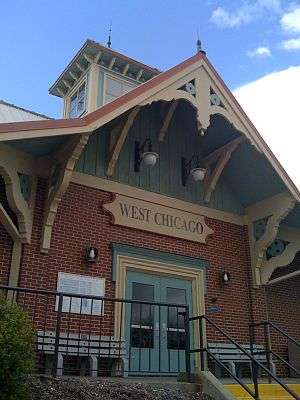West Chicago, Illinois
| West Chicago, Illinois | |
|---|---|
| City | |
 | |
| Motto: "Where History and Progress meet..." | |
 Location in DuPage County and the state of Illinois. | |
| Coordinates: 41°53′18″N 88°12′35″W / 41.88833°N 88.20972°WCoordinates: 41°53′18″N 88°12′35″W / 41.88833°N 88.20972°W | |
| Country |
|
| State | Illinois |
| County | DuPage |
| Townships | Winfield, Wayne |
| Incorporated | May 31, 1873[1] |
| Government | |
| • Type | Mayor-council |
| • Mayor | Ruben Pineda |
| Area | |
| • Total | 15.14 sq mi (39.2 km2) |
| • Land | 14.80 sq mi (38.3 km2) |
| • Water | 0.34 sq mi (0.9 km2) 2.25% |
| Population (2010)[2] | |
| • Total | 27,086 |
| • Density | 1,800/sq mi (690/km2) |
| Standard of living | |
| • Per capita income | $19,287 (median: $63,424) |
| • Home value | $192,993 (median: $160,200) |
| ZIP code(s) | 60185, 60186 |
| Area code(s) | 630 and 331 |
| Geocode | 80060 |
| Website |
www |
| Demographics (2010)[2] | |||
|---|---|---|---|
| White | Black | Hispanic | Asian |
| 67.6% | 2.5% | 51.1% | 5.9% |
| Islander | Native | Other | |
| 0.1% | 0.6% | 22.3% | |
West Chicago is a city in DuPage County, Illinois, United States. The population was 27,086 at the 2010 census. It was formerly named Junction and later Turner, after its founder, John B. Turner, president of the Galena and Chicago Union Railroad (G&CU) in 1855.[3] The city was initially established around the first junction of railroad lines in Illinois,[4] and today is still served by the Union Pacific West Metra service via West Chicago station.
Geography
West Chicago is located at 41°53′18″N 88°12′35″W / 41.888378°N 88.209659°W.[5]
According to the 2010 census, West Chicago has a total area of 15.141 square miles (39.22 km2), of which 14.8 square miles (38.33 km2) (or 97.75%) is land and 0.341 square miles (0.88 km2) (or 2.25%) is water.[6]
History

The most notable early settler in the area was Erastus Gary, of Pomfret, Connecticut, who homesteaded 760 acres (310 ha) on the banks of the DuPage River, just south of West Chicago's present day city limits in the 1830s. Gary was the father of "Judge" Elbert Henry Gary, for whom Gary, Indiana is named, and who was the first CEO of America's first billion-dollar corporation, U.S. Steel. Gary was also instrumental in bringing brothers Jesse and Warren Wheaton, founders of nearby Wheaton, Illinois, the DuPage County seat, from Connecticut to the Midwest. A pioneer cemetery on the old Gary Homestead, where a sawmill had been built by the Garys, just north of Gary's Mill Road, and north of its terminus at Illinois Route 59, was built over with apartment buildings in the 1960s.
In 1849, the Galena and Chicago Union Railroad (predecessor of the C&NW) reached the site of present-day West Chicago, then continued northwest to Elgin. In 1850, the Aurora Branch Railroad (predecessor of the CB&Q) built southwest, making America's first railroad junction point west of Chicago. In 1854, the G&CURR opened the “Dixon Air Line” branch West thru Geneva.[7][8][9]
Because of the number of trains passing through town, water and fuel facilities for locomotives and a roundhouse were built here, as well as an early eating-house and hotel for travelers. As a result, a number of new employees and their families located to this community. The original settlers were primarily English and Irish, with Germans arriving in the 1860s and Mexican immigrants by the 1910s.
John B. Turner, president of the G&CU and a resident of Chicago, owned several acres of land in what is now the center of town. As more people settled in Junction, Turner recognized the chance to make a profit by platting his land and selling off lots. He therefore recorded the community’s first plat in 1855 under the name of Town of Junction.
The community continued its growth, and in 1857, Dr. Joseph McConnell and his wife Mary platted a second portion of town just north of John B. Turner’s plat. They recorded their plat as the Town of Turner in honor of the railroad president. These two “towns” became informally known as Turner Junction.
By 1873, the community had taken on a substantial and permanent character, so the residents incorporated as the Village of Turner. In 1888, a new railroad, the Elgin, Joliet & Eastern, built a freight line through town. It offered free factory sites for any industry willing to locate along its right-of-way. As part of the effort to attract industry, the community changed its name in 1896 to the Village of West Chicago. Area businessmen, particularly Charles Bolles, reasoned that the new name sounded more cosmopolitan, and would help draw prospective factory owners.
As industry located in West Chicago and new jobs opened up, the population increased. At the turn of the century, West Chicago was number two in population in DuPage County, behind Hinsdale. By 1910, the population was 2,378 and several new industries had located here, including the Borden’s milk condensing plant, the Turner Cabinet Company and the Turner Brick Company. The community continues to attract quality business and residential development that contributes to the culturally diverse community that exists today.[10]
In 1909, one more railroad came to West Chicago. The Chicago, Wheaton and Western Railway, a lightly built interurban electric railway, came in from the east, running down the middle of Junction and Depot (now both Main) streets, then curved back west toward Geneva. Soon bought by the Chicago Aurora and Elgin Railroad, the “country trolley” was lightly used, and abandoned in 1937. The right of way is now the Geneva Spur of the Illinois Prairie Path.[11][12][13][14][15]
In the 1980s/90s, the city received a scare due to the nuclear-waste contamination scandal. Harmful waste from the Rare Earths Facility had been spread around the community since the 1930s, when the facility was founded by the Lindsay Light and Chemical Company. One contaminated site was Reed-Keppler Park, which was built on top of a landfill that had received some waste from the plant. Kerr-McGee, which had bought the facility in 1967 and operated it until 1973,[16][17][18] settled with the city, cleaning up the waste.
The movie Reach the Rock, written by John Hughes, was filmed in downtown West Chicago in 1998.
West Chicago is also the birthplace of Josh Urban, who is better known as the WWF wrestler "Hacksaw" Jim Duggan.
The city has undergone a massive face-lift since 2001, especially in the downtown area, the corner of Route 59 and Main Street.
Government
The United States Postal Service operates the West Chicago Post Office.[19]
Demographics
| Historical population | |||
|---|---|---|---|
| Census | Pop. | %± | |
| 1880 | 1,001 | — | |
| 1890 | 1,506 | 50.4% | |
| 1900 | 1,877 | 24.6% | |
| 1910 | 2,378 | 26.7% | |
| 1920 | 2,594 | 9.1% | |
| 1930 | 3,477 | 34.0% | |
| 1940 | 3,355 | −3.5% | |
| 1950 | 3,973 | 18.4% | |
| 1960 | 6,854 | 72.5% | |
| 1970 | 9,988 | 45.7% | |
| 1980 | 12,550 | 25.7% | |
| 1990 | 14,796 | 17.9% | |
| 2000 | 23,469 | 58.6% | |
| 2010 | 27,086 | 15.4% | |
| Est. 2015 | 27,447 | [20] | 1.3% |
As of 2010, West Chicago had a population of 27,086. The population was 67.6% White, 2.5% Black, 0.6% Native American, 5.9% Asian, 0.1% Pacific Islander, and 2.7% from two or more races. 51.1% of the population was Hispanic or Latino of any race.[22]
As of the census of 2000,[23][24] there were 23,469 people, 6,379 households, and 5,230 families residing in the city. The population density was 1,695.9 people per square mile (654.7/km²). There were 6,567 housing units at an average density of 474.5 per square mile (183.2/km²). The racial makeup of the city was 77.85% White, 1.68% African American, 0.36% Native American, 1.95% Asian, 0.03% Pacific Islander, 15.11% from other races, and 3.01% from two or more races. Hispanic or Latino of any race were 48.60% of the population.
There were 6,379 households out of which 48.3% had children under the age of 18 living with them, 66.3% were married couples living together, 8.4% had a female householder with no husband present, and 18.0% were non-families. 12.8% of all households were made up of individuals and 2.7% had someone living alone who was 65 years of age or older. The average household size was 3.64 and the average family size was 3.91.
In the city, the population was spread out with 31.6% under the age of 18, 13.4% from 18 to 24, 34.6% from 25 to 44, 15.8% from 45 to 64, and 4.7% who were 65 years of age or older. The median age was 28 years. For every 100 females there were 114.2 males. For every 100 females age 18 and over, there were 117.0 males.
The median income for a household in the city was $63,424, and the median income for a family was $65,744. Males had a median income of $39,723 versus $27,285 for females. The per capita income for the city was $19,287, the lowest in DuPage County. About 6.8% of families and 9.3% of the population were below the poverty line, including 10.5% of those under age 18 and 3.8% of those age 65 or over.
Economy
Jel Sert has its corporate headquarters in West Chicago.[25]
Ball Horticultural Company has its Worldwide Headquarters in West Chicago.[26]
General Mills has a production facility in West Chicago.
Top employers
According to the City's 2009 Comprehensive Annual Financial Report,[27] the top employers in the city are:
| # | Employer | # of Employees |
|---|---|---|
| 1 | Jel Sert | 1,000 |
| 2 | West Chicago Elementary School District | 632 |
| 3 | General Mills | 510 |
| 4 | Ball Horticultural Company | 434 |
| 5 | Siemens Energy & Automation | 306 |
| 6 | Aspen Marketing Services | 281 |
| 7 | Buck Services | 260 |
| 8 | Community High School District 94 | 257 |
| 9 | OSI Group | 230 |
| 10 | WinCup | 212 |
| 11 | Turtle Splash | 200 |
| 12 | Mapei | 190 |
| 13 | Express Packaging | 175 |
| 14 | Pella | 175 |
| 15 | St. Andrews Golf & Country Club | 160 |
Education
The city of West Chicago has two high schools—one public school, West Chicago Community High School, and one private, Wheaton Academy. There are seven public elementary schools (Currier, Pioneer, Wegner, Turner, Indian Knoll, Gary, and Norton Creek) and two middle schools [Benjamin and Leman Middle School (LMS)] within the city.[28] The West Chicago Wildcats is the name of the WCCHS teams.
Transportation

The DuPage Airport is located in the city.[29] The National Transportation Safety Board operates the Chicago Aviation Field Office in West Chicago, on the grounds of the airport; it is the regional headquarters of the NTSB Aviation Central Region.[29][30]
Metra has a station on the Union Pacific West Line and another is being planned on the STAR Line on North Avenue.
Points of interest
West Chicago is home to the Truitt-Hoff Nature Preserve, part of DuPage County’s West Chicago Prairie Forest Preserve, one of the largest and best preserved prairies in the Midwest.[31] This prairie was discovered by then-mayor Richard Truitt in 1976 during one of his frequent walks in the open land west of the city. The prairie had been preserved because it was on railroad right-of-way land that had never been cultivated.[31]
The city is also home to Kline Creek Farm, an 1890s living history farm.[32]
References
- ↑ Illinois Regional Archives Depository System. "Name Index to Illinois Local Governments". Illinois State Archives. Illinois Secretary of State. Retrieved 2011-11-14.
- 1 2 "Community: Demographics". City of West Chicago, Illinois. 2010. Retrieved 18 January 2013.
- ↑ "Several Towns Named After Founders and Heroes". The Daily Herald. December 28, 1999. p. 220. Retrieved August 17, 2014 – via Newspapers.com.

- ↑ Reiff, Janice L.; Ann Durkin Keating; James R. Grossman. "West Chicago, IL". Encyclopedia of Chicago. Chicago History Museum; Newberry Library; University of Chicago. Retrieved 2010-03-06.
- ↑ "US Gazetteer files: 2010, 2000, and 1990". United States Census Bureau. 2011-02-12. Retrieved 2011-04-23.
- ↑ "G001 - Geographic Identifiers - 2010 Census Summary File 1". United States Census Bureau. Retrieved 2015-12-27.
- ↑ Casey, Robert J.; Douglas, W.A.S. (1948). Pioneer Railroad. McGraw-Hill. pp. 60–61.
- ↑ Grant, H. Roger (1996). The North Western. Northern Illinois University Press. p. 15. ISBN 0-87580-214-1.
- ↑ Scobey, Frank F.; Musich, Gerald D. (1984). A Brief History of An Old Railroad Town. City of West Chicago Historical Museum. pp. 10–11.
- ↑ Scobey-Musich(1984)
- ↑ The Great Third Rail. Central Electric Railfans’ Association. 1961. pp. 36, 58–59, II–10.
- ↑ Peffers, Hopkins Stolp (1993). Aurora-Elgin Area Street Cars and Interurbans V. 3 The Third Rail Line. American Slide-Chart Corp. pp. 76–80. ISBN 1-883461-03-0.
- ↑ Plachno, Larry (1986). Sunset Lines The Story of the Chicago Aurora, & Elgin Railroad: 1 - Trackage. Transportation Trails. pp. 137–141. ISBN 0-933449-02-X.
- ↑ Plachno, Larry (1989). Sunset Lines The Story of the Chicago Aurora & Elgin Railroad: 2 — History. Transportation Trails. pp. 243–251. ISBN 0-933449-10-0.
- ↑ Scobey-Musich(84) page 16
- ↑ U.S. Environmental Protection Agency (February 1990). "NPL Site Narrative for Kerr-McGee (Residential Areas)". Retrieved 2009-10-02.
- ↑ Starks, Tamara (1993-03-21). "Death in the Sandbox - West Chicago, Ill., Neighborhood Quakes Over Radioactive Soil". Associated Press / Los Anegeles Times. Retrieved 2009-10-02.
- ↑ "Superfund Site Report: KERR-MCGEE (REED-KEPPLER PARK)". scorecard.org. Retrieved 2009-10-02. (based partly on US EPA NPL narrative)
- ↑ "Post Office Location - WEST CHICAGO." United States Postal Service. Retrieved on May 15, 2010.
- ↑ "Annual Estimates of the Resident Population for Incorporated Places: April 1, 2010 to July 1, 2015". Retrieved July 2, 2016.
- ↑ "Census of Population and Housing". Census.gov. Retrieved June 4, 2015.
- ↑ 2010 census quickfacts page for West Chicago, census.gov
- ↑ "American FactFinder". United States Census Bureau. Retrieved 2008-01-31.
- ↑ 2000 United States Census Data
- ↑ "Contact Us." Jel Sert. Retrieved on May 15, 2010.
- ↑ "" Ball Horticultural Company
- ↑ City of West Chicago CAFR
- ↑ http://www.city-data.com/school/West-Chicago-Illinois.html#top
- 1 2 "2010 Zoning Map." City of West Chicago. Retrieved on May 15, 2010.
- ↑ "Regional Offices: Aviation." National Transportation Safety Board. Retrieved on May 15, 2010.
- 1 2 "West Chicago Prairie". Forest Preserve District of DuPage County. Retrieved 18 January 2013.
- ↑ "Kline Creek Farm". Forest Preserve District of DuPage County. Retrieved 18 January 2013.
External links
| Wikimedia Commons has media related to West Chicago, Illinois. |
| Wikivoyage has a travel guide for West Chicago. |
- Official website
- West Chicago Community High School Web Site
- Encyclopedia of Chicago History
- WegoNews, Micro-Gateway for the City of West Chicago
- West Chicago Fire Protection District Web Site
